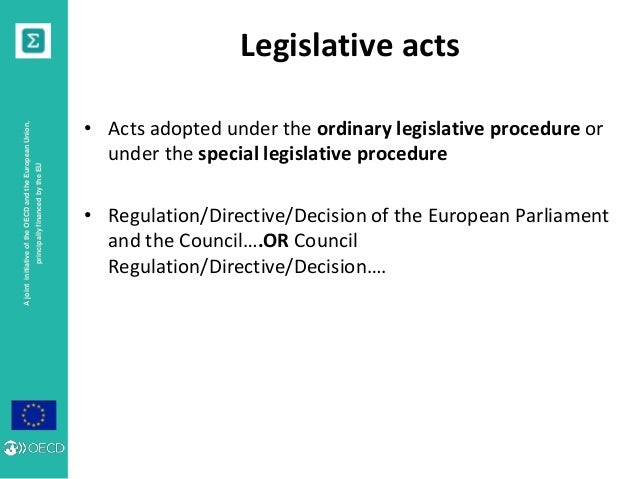A regulation is a binding legislative act. It must be applied in its entirety across the EU. After transmission of the draft legislative act to the national parliaments, Having regard to the opinion of the European Central Bank Having regard to the opinion of the European Economic and Social Committee Acting in accordance with the ordinary legislative procedure OJ C 3 31. Legal Acts of the European Union are laws which are adopted by the Institutions of the European Union in order to exercise the powers given to them by the EU Treaties.
They come in five forms: regulations, directives, decisions, recommendations and opinions. Regulations and directives can be either legislative or non- legislative acts. Directives and regulations are two forms of laws that can be passed by the European Union. According to Europa, the official European Union website, a directive is a legislative act that sets out a goal that all EU countries must achieve.
In terms of regulation, Europa says that. Directives can be adopted by means of a variety of legislative procedures depending on their subject matter. The text of a draft directive (if subject to the co-decision process, as contentious matters usually are) is prepared by the Commission after consultation with its own and national experts. Legislative train schedule help.
Two directives have been adopted using this procedure: one on transparency between member states and companies and another on competition in the telecommunications sector. Formally speaking, these acts are not legislative acts. What is the difference between Directive and Regulation?
Directives are also legislative acts of the Parliament but are general in nature and not binding. The General Product Safety Directive complements sector specific legislation such as specific rules that apply to toys, electrical and electronic goods, cosmetics, chemicals and other specific product groups. It does not cover pharmaceuticals, medical devices or foo which fall under separate legislation. The new act passes through the full legislative process and replaces the acts being codified. Consolidation of EU law a formal procedure combining within a single legislative text the provisions of a basic legislative act and all subsequent amendments.
No amendments are made to the content or form of the existing legislative document. Directive summaries are available only in English, but links at the end of each summary lead to the full text of the directive in all EU languages. In addition to the Framework Directive , a series of individual directives focusing on specific aspects of safety and health at work were adopted.
Nevertheless, the Framework Directive continues to. Directive – a legislative act that requires all EU countries to achieve a particular result but does not dictate how the result should be achieved. Regulation – a legislative act that is immediately enforceable as law in all EU countries.

Final legislative act with provisions for delegated acts. Public procurement 3. Road transport: passengers and freight 3. Motor industry, cycle and motorcycle, commercial and agricultural vehicles 3. Close the navigation (menu) Change the navigation language. Current language: en - English. Although enormously influential in shaping the laws of the lan The House of Lords are not actually a legislative body.
On average, the Council adopts 1legislative acts per year. A directive is a legal act provided for in the EU Treaty. It is binding in its entirety and obliges Member States to transpose it into national law within a set deadline. Where, in the cases provided for in the Treaties, a legislative act is submitted to the ordinary legislative procedure on the initiative of a group of Member States, on a recommendation by the European Central Bank, or at the request of the Court of Justice, paragraph the second sentence of paragraph and paragraph shall not apply.
This Directive sets out principles and general directions on how these objectives are to be met. Directiva este un act legislativ care stabilește un obiectiv pe care trebuie să îl atingă toate statele membre. Fiecare dintre ele are însă libertatea de a decide asupra modalităților de îndeplinire a obiectivului stabilit.
Keine Kommentare:
Kommentar veröffentlichen
Hinweis: Nur ein Mitglied dieses Blogs kann Kommentare posten.